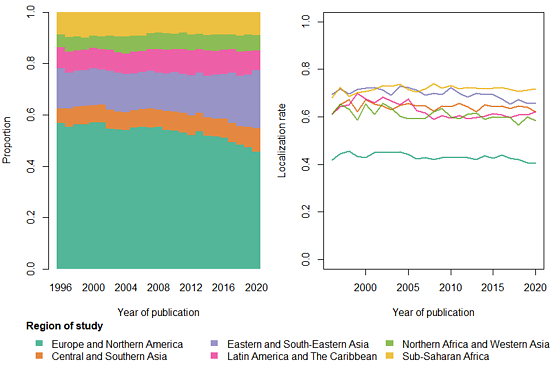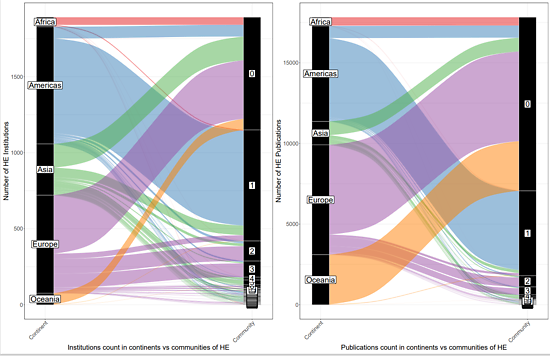Arbeitsbereich
Bevölkerungsdynamik und Nachhaltiges Wohlbefinden
Auf einen Blick
Projekte
Publikationen
Team
Projekt
Trends and Disparities in Patterns of Scientific Knowledge Production
Aliakbar Akbaritabar, Diego Alburez-Gutierrez, Andres Castro (MPIDR / Computational Social Sciences and Humanities Programme, Barcelona Supercomputing Center, Spanien); in Zusammenarbeit mit Vincent Larivière (University of Montreal, Kanada), Cassidy R. Sugimoto (Georgia Institute of Technology, Atlanta, Vereinigte Staaten), Flaminio Squazzoni (Università degli Studi di Milano, Italien), Dimity M. Stephen (German Centre for Higher Education Research and Science Studies GmbH, Hannover, Deutschland), Dehua Gao (Shandong Technology and Business University, Yantai City, China)
Ausführliche Beschreibung
The digitization of data across different contexts has led to the increased accumulation and gathering of science and scientific metadata that have been released through proprietary and licensed databases. Bibliometric data, i.e., information extracted from scientific publications, can be considered a source of digital trace data of scientists’ behaviors. It is thus possible to use this data to study inequalities in patterns of scientific production worldwide.
A number of scientific fields leverage bibliometric data, including the science of science, scientometrics, and the sociology of science. These fields deal with a diverse set of research questions aimed at understanding how scientists do science, who collaborates with whom, and what kind of teams develop and produce more scientific breakthroughs than others. In these contexts, bibliometric data are used, for example, to trace scientists’ behaviors, investigate science systems, or assess gender disparities in academia.
The use of bibliometric data in demographic research can be roughly divided into two classes. One class of studies looks at the populations of scholars and uses bibliometric data to study their composition and dynamics across different national science systems and over time, including disparities by gender or academic age. The second class repurposes bibliometric data and treats it similarly to digital traces to study, for example, scholars’ mobility and migration. These data are often combined with other sources such as geo-spatial data, surveys, and administrative data to provide more context to the scientists’ behaviors.
In this project, we study global trends in scientific knowledge production in the form of scientific publications. We investigate the structure of scientific collaboration worldwide and how this collaboration varies in different national contexts and among fields of science. We also investigate the behaviors of scientists along the following questions: (i) How do scientists select research questions and analysis frameworks? (ii) With whom do they collaborate? (iii) How do they react to national or global incentives in research assessment exercises? (iv) Do they have specific tendencies in how they present their work depending on the research focus being on the Global North or Global South?
In one study, we used Scopus data from 1996 to 2020 to understand whether publications have a different tendency in mentioning the regions they focus on. We have found that publications studying the Global North have a higher tendency not to mention the region, whereas studies on the Global South did mention the region much more often.
In a related study, we focused on the rate of internationalized scientific collaborations worldwide in studies produced by scholars in higher education. We investigated whether these scholars, located in different geographic regions, had different tendencies for international collaboration. We have found a highly internationalized structure of collaboration in Europe, Asia, Africa, and Oceania, and a locally structured collaboration structure in the Americas.
Benennungspraktiken bei der Erwähnung des geografischen Schwerpunkts im Titel wissenschaftlicher Veröffentlichungen

Während sich etwa 60 % der Artikel auf Europa und Nordamerika konzentrieren (links), werden diese Regionen nur in 40 % der Artikel im Titel erwähnt (rechts). Bei den anderen Regionen der Welt verhält es sich umgekehrt. Die Abbildung zeigt die Verteilung der Schwerpunktregion der Artikel in der Analysestichprobe (links) und die Lokalisierungsrate nach Studienregion (rechts), 1996 bis 2020 (n = 560.893). Autoren aus dem globalen Süden geben den geografischen Schwerpunkt ihrer Artikel deutlich häufiger an. © Based on the paper by Castro Torres, A. F., & Alburez-Gutierrez, D. (2022). North and South: Naming practices and the hidden dimension of global disparities in knowledge production. Proceedings of the National Academy of Sciences, 119(10), e2119373119
Die regionale Konzentration von Wissenschaft und wissenschaftlicher Zusammenarbeit

Während Einrichtungen in Nord-, Mittel- und Südamerika hauptsächlich mit anderen Einrichtungen innerhalb derselben Region zusammenarbeiten, kooperieren Europa, Afrika und Ozeanien miteinander und zeigen einen viel stärkeren Trend zur internationalisierten Zusammenarbeit im Bereich der Hochschulstudien. Die Abbildung zeigt die Verteilung der Hochschuleinrichtungen aus verschiedenen Kontinenten (linke Spalte der beiden Tafeln) im Vergleich zu ihrer Mitgliedschaft in 36 Hochschulnetzwerken. Die rechte Spalte der beiden Tafeln zeigt die zusammenhängenden Untergruppen (d. h. Gemeinschaften), die wir in ihrem Kooperationsnetzwerk identifiziert haben. Die Ko-Autorenschaft von Veröffentlichungen wird in ein Netzwerk umgewandelt, in dem Autoren einer Einrichtung mit Autoren einer anderen Einrichtung zusammenarbeiten (die linke Spalte zeigt die Größe der Gemeinschaften auf der Grundlage der Anzahl der Einrichtungen, die rechte Spalte zeigt die Produktivität auf der Grundlage der Anzahl der Veröffentlichungen). © Based on the paper by Akbaritabar, A., & Barbato, G. An internationalised Europe and regionally focused Americas: A network analysis of higher education studies. European Journal of Education, 56(2), 219–234.
Bildung und Wissenschaft, Kultur, Projektionen und Vorhersagen, Statistik und Mathematik
Deutschland, Europa, Italien, Welt
Publikationen
Akbaritabar, A.; Carrasco Armijo, J. I.; Anastasiadou, A.:
MPIDR Working Paper WP-2025-004. (2025)

Akbaritabar, A.:
EPJ Data Science 13:14, 1–12. (2024)

Akbaritabar, A.; Castro Torres, A. F.; Larivière, V.:
Humanities and Social Sciences Communications 11:914, 1–10. (2024)

Akbaritabar, A.; Rubin, B. P.:
Journal of the History of the Neurosciences, 1–22. (2024)
Basellini, U.:
Demographic Research 50:43, 1265–1280. (2024)

Castro Torres, A. F.; Akbaritabar, A.:
Quantitative Science Studies, 1–32. (2024)

Abdi Nur, A.; Akbaritabar, A.; Vignau Loria, M.; Coolman, N.; Fan, X.; Curran, S.:
MPIDR Working Paper WP-2023-027. (2023)

Akbaritabar, A.:
In: 19th International Conference on Scientometrics and Informetrics, ISSI 2023: 2-5 July 2023, Indiana University, Bloomington, IN, USA; proceedings: volume 1, 19–41. Bloomington, IN: Indiana University. (2023)

Akbaritabar, A.; Castro Torres, A. F.; Larivière, V.:
MPIDR Working Paper WP-2023-029. (2023)

Akbaritabar, A.; Stephen, D.; Squazzoni, F.:
Journal of Informetrics 16:2, 101258–101258. (2022)
Castro Torres, A. F.; Akbaritabar, A.:
arXiv e-prints 2208.05373. unpublished. (2022)

Castro Torres, A. F.; Alburez-Gutierrez, D.:
Proceedings of the National Academy of Sciences of the United States of America 119:10, e2119373119–e2119373119. (2022)

Gao, D.; Akbaritabar, A.:
Review of Managerial Science 16:2, 521–550. (2022)
Piolatto, M.; Bianchi, F.; Rota, M.; Marengoni, A.; Akbaritabar, A.; Squazzoni, F.:
BMC Public Health 22:278, 1–14. (2022)

Akbaritabar, A.:
Quantitative Science Studies 2:2, 753–777. (2021)

Akbaritabar, A.; Barbato, G.:
European Journal of Education 56:2, 219–234. (2021)

Akbaritabar, A.; Bravo, G.; Squazzoni, F.:
Science and Public Policy 48:5, 662–678. (2021)

Castro Torres, A. F.; Alburez-Gutierrez, D.:
MPIDR Working Paper WP-2021-014. (2021)
